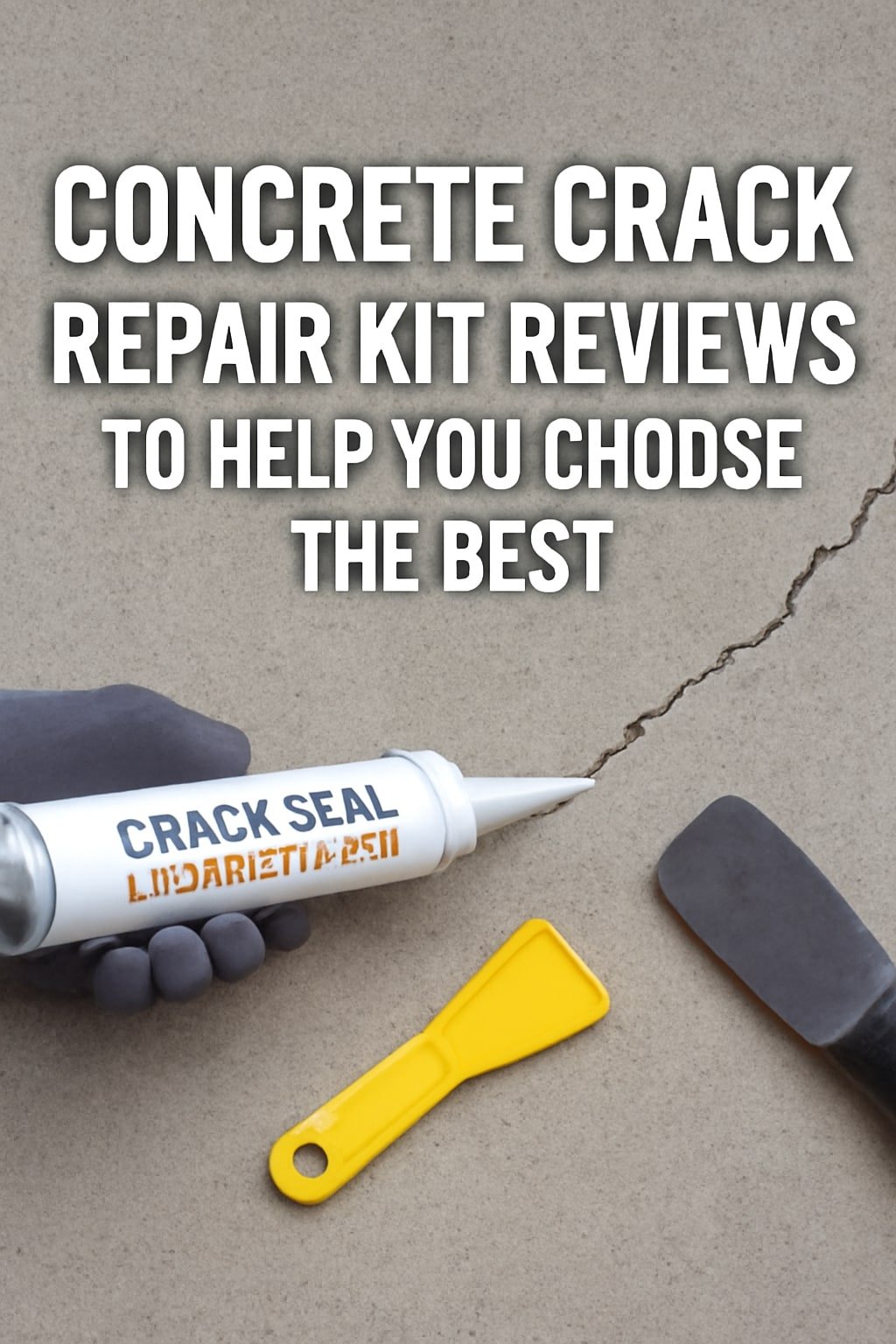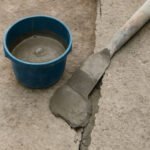Concrete crack repair kits are essential tools for anyone looking to maintain the integrity and appearance of their concrete surfaces. Whether it’s your driveway, patio, or foundation, cracks can lead to bigger structural problems if left untreated. This article dives deep into concrete crack repair kit reviews to help you choose the best product for your needs. We’ll cover everything from types of repair kits, key features, detailed reviews of the top 7 kits, and helpful tips to ensure your repairs last.
Introduction to Concrete Crack Repair Kits
Concrete is a durable material but is susceptible to cracking due to weather changes, settling, or impact. Small cracks might seem harmless but can expand and cause water infiltration, freeze-thaw damage, or structural issues. That’s where concrete crack repair kits come into play — they offer a cost-effective, DIY-friendly solution to fix cracks before they worsen.
Concrete crack repair kits typically include a filler material and tools to apply it. Using the right kit can restore your concrete’s strength, prevent further damage, and improve its look. Understanding your options and what to look for is key to making a smart purchase.
Why You Need a Concrete Crack Repair Kit
Using a concrete crack repair kit is often the best first step for managing minor to moderate cracks. Hiring professionals to fix cracks can get expensive quickly, especially for small projects around the house. Repair kits provide a budget-friendly alternative that empowers homeowners to handle repairs themselves.
Cost-Effectiveness of Repair Kits
Professional concrete repairs may cost hundreds or even thousands of dollars, depending on the damage extent. A repair kit, on the other hand, typically ranges from $20 to $80, making it an affordable choice for quick fixes. This cost-effectiveness doesn’t sacrifice quality when the right kit is chosen.
DIY Convenience and Accessibility
Most kits are designed with DIY users in mind. They come with detailed instructions and all necessary components, so even beginners can apply them with confidence. This convenience saves time and hassle compared to coordinating professional service calls.
Types of Concrete Crack Repair Kits
Concrete crack repair kits come in various formulations suited to different crack types and conditions. Knowing the differences will help you select a kit that matches your repair needs.
Epoxy-Based Kits
Epoxy kits are known for their strong adhesive qualities and durability. They bond tightly with the concrete, restoring structural integrity in cracks. Epoxy kits work best for cracks that need a rigid, permanent fix.
Polyurethane-Based Kits
Polyurethane kits offer more flexibility than epoxy. They resist water and can expand or contract slightly with temperature changes, making them ideal for cracks subject to movement or moisture exposure.
Cementitious Repair Kits
Cement-based kits mimic the original concrete composition and are suitable for larger cracks or surface repairs. These kits often come with additives for enhanced bonding and weather resistance.
Key Features to Look for in a Concrete Crack Repair Kit
When choosing a repair kit, consider these essential features:
Durability and Longevity
Select kits with proven durability to avoid recurring repairs. Look for user reviews or manufacturer data on weather resistance and lifespan.
Ease of Application
Kits that include clear instructions and user-friendly tools simplify the repair process. Some kits come with syringes or nozzles for precise application.
Weather and Water Resistance
Depending on your environment, pick kits that withstand freeze-thaw cycles, rain, or UV exposure to ensure lasting repairs.
Kit Contents and Tools Included
Complete kits should provide the filler material, applicator tools, cleaning implements, and sometimes safety gear to help you get the job done without extra purchases.
Top 7 Concrete Crack Repair Kits Reviewed
Here’s a detailed look at seven popular concrete crack repair kits, their features, pros, cons, and price points to help you make an informed choice.
Kit 1: Quikrete Concrete Crack Seal
- Features: Water-based, fast-drying, flexible sealant; designed for cracks up to 1/2 inch wide.
- Pros: Easy to apply with a squeeze bottle, excellent adhesion.
- Cons: May require reapplication in heavy traffic areas.
- Price: Approximately $15 per kit.
Kit 2: SikaFlex Self-Leveling Sealant
- Features: Polyurethane-based, self-leveling for horizontal cracks.
- Pros: High elasticity, water-resistant, durable.
- Cons: Application requires careful preparation.
- Price: Around $25 per tube.
Kit 3: DAP Concrete & Masonry Filler and Sealant
- Features: Acrylic latex formula, paintable, ideal for small cracks.
- Pros: Easy cleanup, good for interior and exterior use.
- Cons: Less durable for larger structural cracks.
- Price: $10-$12 per tube.
Kit 4: Rust-Oleum EpoxyShield Concrete Patch and Repair
- Features: Epoxy-based, high strength, water-resistant.
- Pros: Excellent bonding, long-lasting.
- Cons: Slightly more difficult to apply for novices.
- Price: Around $20 per kit.
Kit 5: Sakrete Concrete Crack Filler
- Features: Cementitious mix, ready to use.
- Pros: Great for wider cracks, strong finish.
- Cons: Longer drying time.
- Price: $18 per kit.
Kit 6: Simpson Strong-Tie Crack-Pac Injection Epoxy
- Features: Injection epoxy for deep crack filling.
- Pros: Professional-grade strength, seals hairline to large cracks.
- Cons: More complex application process.
- Price: $50 and up.
Kit 7: Loctite Epoxy Heavy Duty
- Features: Two-part epoxy, fast curing.
- Pros: Versatile, durable, and bonds well.
- Cons: Limited working time after mixing.
- Price: Approximately $15 per pack.
How to Choose the Right Concrete Crack Repair Kit for Your Needs
Picking the best kit depends on the specific nature of your cracks, environmental factors, and budget.
Assessing the Crack Type and Size
Hairline cracks may only require flexible sealants, while structural cracks often call for epoxy or cementitious repairs.
Considering Environmental Conditions
For outdoor cracks exposed to moisture or freeze-thaw cycles, water-resistant and flexible kits are preferable.
Budget Considerations
While cheaper kits may work for minor repairs, investing in quality materials prevents future expenses.
Step-by-Step Guide to Using a Concrete Crack Repair Kit
Preparation of the Crack Area
Clean out debris, dust, and loose concrete using a wire brush or vacuum. Make sure the area is dry if using epoxy or polyurethane products.
Mixing and Applying the Repair Material
Follow manufacturer instructions carefully. Mix epoxy or cement-based fillers thoroughly, and apply evenly using provided tools.
Curing and Finishing
Allow adequate curing time, often 24-48 hours, before exposing the repair to traffic or water. Smooth and finish the surface as needed.
Maintenance Tips to Extend the Life of Your Concrete Repair
- Inspect repaired areas regularly for new cracks.
- Keep concrete clean and free from standing water.
- Seal surfaces periodically to protect from moisture intrusion.
Common Mistakes to Avoid When Using Concrete Crack Repair Kits
- Ignoring proper surface preparation.
- Applying filler in wet or dirty cracks.
- Using the wrong type of repair material for the crack.
- Rushing the curing process.
Frequently Asked Questions (FAQs)
Can I use a concrete crack repair kit on vertical surfaces?
Yes, but choose a kit formulated for vertical application, such as those with non-sag properties.
How long do repairs from these kits last?
Depending on the kit and conditions, repairs can last from several years to over a decade.
Are these kits safe for indoor use?
Most are safe, but always check for VOC content and ventilate well during application.
Can I paint over the repaired crack?
Many kits allow painting once fully cured. Verify this on the product label.
What if the crack continues to grow after repair?
This may indicate structural issues requiring professional evaluation.
Do I need special tools to use these kits?
Most kits come with necessary tools, but some advanced epoxy systems may require injection equipment.
Conclusion and Final Recommendations
Choosing the right concrete crack repair kit depends on your crack type, environment, and budget. The reviewed kits offer options for various needs—from quick DIY fixes to professional-grade repairs. Proper preparation, application, and maintenance ensure your repairs last and protect your concrete surfaces effectively.









